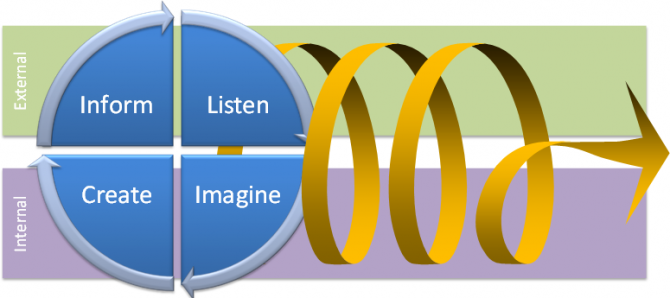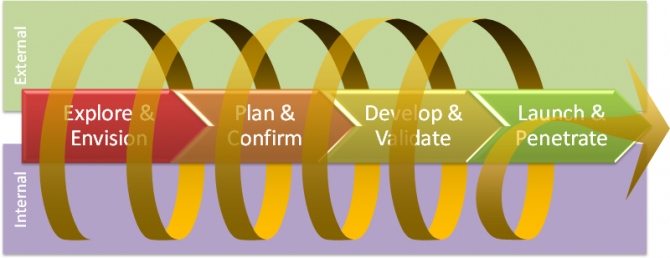Four activities
Listen
 Listening involves understanding the market and the organization’s position in it. Alongside market research there is a careful dialogue with potential users, customers, opinion formers, technologists and other manufacturers and suppliers.
Listening involves understanding the market and the organization’s position in it. Alongside market research there is a careful dialogue with potential users, customers, opinion formers, technologists and other manufacturers and suppliers.
Often employees find it hard to listen closely to during these dialogues. Their own experience of the status quo, or of what is technically possible, leads them to make assumptions about what the customer’s needs really are, what is inferred rather than explicit.
The objective of this activity is to identify unmet needs that represent real commercial opportunities.
Outcomes could include competitive analysis, SWOT, portfolio analysis, future markets scenarios and trends, and, most importantly, a description of user needs. These should be encapsulated in a narrative about what the user is trying to achieve. This story has to be engaging and detailed enough for it to be possible to test alternative solutions against it.
Later in the process listening is used to keep a track of changes in the market, and to check that the product really does fulfil the unmet needs in detail.
Imagine
 Imagining something that does not exist can be difficult. It requires a creative and open-minded attitude which can be hard to find in organisations that have “been there, tried it, and got the T-shirt”.
Imagining something that does not exist can be difficult. It requires a creative and open-minded attitude which can be hard to find in organisations that have “been there, tried it, and got the T-shirt”.
Rather than just focussing on the future product, I like to help the team to imagine a delighted customer, a new way to achieve things, a story about how the world could be better in the future.
A successful technology product will have to fulfil unmet needs in a delightful way, be technically possible and commercial. Two out of three isn’t bad, it’s a failure. For this reason I like to work with a team that can represent all three points of view.
The objective is to build a paradigm for a new product opportunity, or a particular element of that offering.
Outcomes from the activities include a shared understanding of how the user need can be met. Sometimes this is a diagram, a use case scenario, a specification, or often a photograph of a whiteboard and associated notes.
Later in the project we will return to this activity to work out the details of particular features of the product or to respond to changes in the market.
Create
 Nothing tells you whether a product will be a hit quite like seeing a user react to a prototype. Suddenly the conversation switches from hand waving to practical suggestions. Prototypes reveal the unspoken requirements quickly and effectively. The faster you get to a working prototype, the higher your chances of success.
Nothing tells you whether a product will be a hit quite like seeing a user react to a prototype. Suddenly the conversation switches from hand waving to practical suggestions. Prototypes reveal the unspoken requirements quickly and effectively. The faster you get to a working prototype, the higher your chances of success.
Only the engineers can build the product, and they can only build the optimal platform for that product if they understand the long term direction. Hiding behind a “just fulfil the spec” philosophy will lead to problems implementing new features in the future. And, yes, prototypes should be built to be thrown away; otherwise the team will hold on to them too hard and not hear constructive criticism.
The Create activity is all about working with engineers to construct a product which will deliver the benefits, and more, to the identified users, a product that will delight and excite.
Outcomes can be prototypes, early versions and ultimately final products.
Inform
 If your new product is going to conquer the world, the world will need to learn about how amazing it is. We start this process very early in the product’s lifecycle; it grows naturally out of the dialogue with the market.
If your new product is going to conquer the world, the world will need to learn about how amazing it is. We start this process very early in the product’s lifecycle; it grows naturally out of the dialogue with the market.
Early on we’ll be testing our ability to explain the product’s benefits to Early Adopters. We’ll prepare a pitch of a prototype as carefully as any marketing campaign, deliver it and then step back and listen, carefully.
Later, with clear evidence from previous iterations and other activities, we will understand what the product’s benefits are, who will benefit from them, and the language they will understand. Better than that, we will have a number of carefully selected Early Adopters who will be prepared to speak for us about the product, people who will have real integrity in the market.
The objective is to generate interest and excitement around the product and the ultimate outcome is sales.
Iterate
 Some software companies are used to working with an agile development process; few use an agile product management process. This involves frequently working through the four activities of Listen, Imagine, Create and Inform.
Some software companies are used to working with an agile development process; few use an agile product management process. This involves frequently working through the four activities of Listen, Imagine, Create and Inform.
Cycling through these activities in an agile manner allows each to be informed by the lessons of the others, minimises the cost of errors, increases the ability to respond to changes in the market, and will ultimately ensure that the product is successful.
How can we be so sure the product will be successful? Because we will have validated it at every iteration, and will have adapted it in response to that feedback. If it is not going to be successful, it will have been stopped long before release. It may not be the product you first thought you were building, but it will be successful.
Types of activities
One of the things that makes new product develop difficult is that it requires us to do different types of activity in quick succession. These activities require very different types of thinking and mental approach.
Internal and external activities
Listen and Inform are activities which take place in the market. They require us to step out into the field, to meet real customers and engage with them about a shared and mutually beneficial future.
Imagine and Create are largely internal activities where we reflect and act upon what we have learnt in the market, and work together effectively as a team.
Divergent and convergent activities
The activities of Listen and Imagine are largely divergent activities which require a creative widening of scope for the project as new ideas are embraced. Create and Inform are largely convergent, concrete activities focussing in on those ideas and figuring out how to deliver them and explain them.
Moving forward in stages
Throughout this agile and iterative process the project will be moving forward. The organisation will be investing in different activities depending upon the stage, but we keep an eye on the whole process, all the activities and the final objective of the project: delighted users and a successful product.
 Explore & Envision
Explore & Envision
At the beginning of a new product development process it is very easy to waste a lot of time in the “fuzzy front end”. We help focus activity around the fundamental questions of what market, what customers and why. This involves periods of market research, interviews, idea generation, prototyping and customer presentations. Iterative cycles can be very short during this stage as it is possible to see several customers in a day, responding to feedback from one with an updated pitch to the next.
The outcome of this stage is a product concept with the market data and customer feedback to demonstrate that it has the potential to be a concrete commercial opportunity.
Plan & Confirm
Planning is a vital process, despite the fact that we all know plans will have to adapt to changes in the market. Writing down the plans makes them specific and allows them to be shared, discussed, challenged and strengthened.
Early product prototypes can be used to confirm that our concept for the product really will meet the needs of the target customers, and that their needs have not changed.
There is always a risk of spending too much time planning and not moving forward quickly enough. Too much detail will be wasted and the opportunity may be lost. We help you plan all functions, in an integrated way, in enough detail to cost them, and then move on.
The outcome of this stage is a detailed description of how the product will actually meet user needs and of the business activity that will be required to delivery it. This would include projections on revenues, spending and ROI.
Develop & Validate
Mainstream product development should grow in a continuous way from early prototype development. We guide that with use case scenarios, descriptions of users’ problems, collaborative design sessions and specifications where necessary.
With an agile development process there will be regular opportunities to show the maturing product to early adopters and gain their feedback. Errors of understanding, design or implementation will be quickly and cheaply corrected as the development is kept tightly focussed on the needs of the user.
Outcomes are releasable versions of the product at alpha, beta and ultimately full, revenue generating release.
Launch & Penetrate
Having developed a clear definition of user needs, refined and validated this through the new product development process, messaging will be well understood by this point. Launch planning will have been under way since the earliest stages of the project. We will have built up a clear understanding of who our target customers are, what they read, who they listen to, their concerns, language and culture.
Launch activity will include events, press, advertising and social media such as Twitter and Facebook. Channel engagement through explaining the value of the product to the intended customers will motivate the sales team and/or channel partners.
The role of Early Adopters in the launch process can be very important as they will already have experience of using the product through the beta program, but should also be well respected members of this community.
The launch is only the start of the product’s revenue lifecycle. We help plan a continuing roadmap which will help penetrate the market and deliver year-on-year growth.




[…] This post was mentioned on Twitter by Vision Wrangler, Lucy Cooper. Lucy Cooper said: new blog article on new product development process: http://bit.ly/eKJBO6 #prodmgmt […]